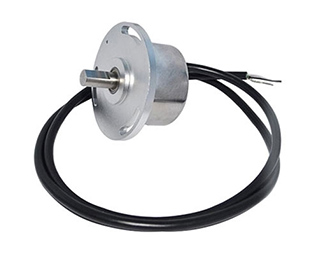What does an Angle Sensor do?
Angle sensors, as the name suggests, are used to detect angles. It has a hole in its body that fits the shaft. When attached to the RCX, the angle sensor counts every 1/16th of a revolution of the shaft. When turning in one direction, the count increases, and when the turning direction changes, the count decreases. The count is related to the initial position of the angle sensor. When the angle sensor is initialized, its count value is set to 0.
Next, let's move to the application of the angle sensor.
Use the angle sensor to control your wheels to detect obstacles indirectly. The principle is very simple. If the motor runs and the gears don't turn, your machine is blocked by an obstacle. This technique is very simple to use and very effective. The only requirement for this technology is that the moving wheels don't slip on the floor (or slip too many times), otherwise you won't be able to detect obstacles. This problem can be avoided if an idle gear is attached to the motor. This wheel is not driven by a motor but is driven by the movement of the device. If the idler stops while the drive wheel is spinning, you have hit an obstacle. This is a typical application of the sensor.
Angle sensors are useful in many situations: Controlling the position of arms, heads, and other movable parts. It is worth noting that when running too slowly or too fast, RCX suffers in terms of accurate detection and counting. In fact, the problem is not with the RCX, but with its operating system, which loses some data if the speed goes beyond its specified limits. Steve Baker has proved through experiments that the speed between 50 and 300 rounds per minute is a more suitable range, and there will be no problem of data loss within this range. However, in the range below 12rpm or above 1400rpm, there will be some data loss problems. In the range of 12rpm to 50rpm or 300rpm to 1400rpm, the RCX also has occasional data loss problems.
In addition, angle sensors, distance sensors, acceleration sensors, these angle sensors have been widely used in petroleum, coal, steel, ship and other industries.
Their typical applications:
Industry: Cranes, hangers, harvesters, cranes, tilt compensation of weighing systems, asphalt machines.
Trains: Inclination measurement of high-speed train bogies and passenger cars.
Maritime: Pitch and roll control, tanker control, antenna position control.
Drilling: Precise drilling tilt control.
Mechanical: Tilt control, large mechanical alignment control, bend control.
Military: Artillery and radar adjustment, initial position control, navigation system, military landing platform control.
Application of angle sensor in military
The well-known artillery is a barrel shooting weapon with a caliber equal to or greater than 20 mm using energy such as gunpowder gas pressure to project projectiles.
As early as 1332, the army was equipped with the earliest metal barrel artillery: the bronze fire gun. The artillery is usually composed of two parts: the gun body and the gun mount. The inclination angle of the gun bed is very high when the artillery is fired. The digital quadrant designed by using the angle sensor can obviously improve the speed of calibrating the gun bed and reduce the difficulty of operation.
The angle sensor is the most helpful as the accuracy and stability of the projectile launch. Everyone knows that the gun barrel is used to give the projectile initial velocity and flight direction, the breech is used to load the projectile, and the breech block is used to close the gun chamber and fire the projectile.
Today, the gun mount is composed of an anti-recoil device, a steering machine, a high and low machine, an aiming device, a large frame and a moving body, and an angle sensor. The anti-recoil device is used to ensure the reset of the artillery after firing the shell, and the direction machine and the height machine are used to ensure the reset of the artillery after the shell is fired. The direction machine and the height machine are used to control the gun body to change the direction and height. The aiming device is composed of an angle sensor, a sight and a sight, which is used to set the artillery shooting data and implement aiming shooting. The large frame and the moving body were used to support the artillery when firing, and as a gun carriage when marching.

